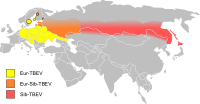
Photo from wikipedia
INTRODUCTION In Poland, the number of reported cases of tick-borne encephalitis, and thus the designation of the regions of TBE occurrence, seems to be underestimated. AIM OF THE STUDY The… Click to show full abstract
INTRODUCTION In Poland, the number of reported cases of tick-borne encephalitis, and thus the designation of the regions of TBE occurrence, seems to be underestimated. AIM OF THE STUDY The aim of the study was to evaluate the impact of the implementation of TBE virus infection tests in the routine diagnostics of patients with neuroinfections of undetermined viral etiology on the identification of TBE virus infections in areas considered non-endemic and finding new areas of TBE occurrence. MATERIAL AND METHODS Twenty-nine departments in which patients with suspected neuroinfections are hospitalized participated in the study. The criterion for selecting the center was the location in an area considered non-endemic for TBE, where reporting is low or absent, and intermediate data indicate the possibility of undiagnosed disease (TBE). Diagnostics were performed in the Immunoserology Laboratory at the Department of Infectious Diseases and Neuroinfections of the Medical University of Bialystok using the ELISA method. The cooperation was undertaken with infectious wards or patients with suspected neuroinfection who are hospitalized and diagnosed (e.g., neurology ward). The supervising unit is the Department of Infectious Diseases and Neuroinfections of the Medical University of Bialystok, ul. Żurawia 14, 15-540 Białystok. For testing the submitted serum and CSF samples by ELISA method were used commercial kits from Virotech (Germany). RESULTS A total of 577 samples from 417 patients were tested, including 290 serum samples and 287 CSF samples. Serum antibodies against TBE were detected: IgM class in 27 samples, IgG class in 22 samples; in CSF: IgM class in 39 samples, IgG in 21 samples. The etiology of TBE was confirmed in 55 cases, i.e. in 13.19% of all tested people. CONCLUSIONS 1. Detection of the presence of antibodies against TBE in samples of patients with meningitis reported as other neuroinfections indicates the etiology of TBE. 2. The number of TBE cases may be undiagnosed, and thus underestimated due to the failure to perform serological tests for TBE in areas considered non-endemic. 3. The diagnosis and reporting of neuroinfections caused by the TBE virus is essential for a proper risk assessment and in promoting prophylaxis in the form of vaccinations. 4. Preliminary results of the research indicate the need for their continuation in all voivodeships.
Journal Title: Przeglad epidemiologiczny
Year Published: 2022
Link to full text (if available)
Share on Social Media: Sign Up to like & get
recommendations!